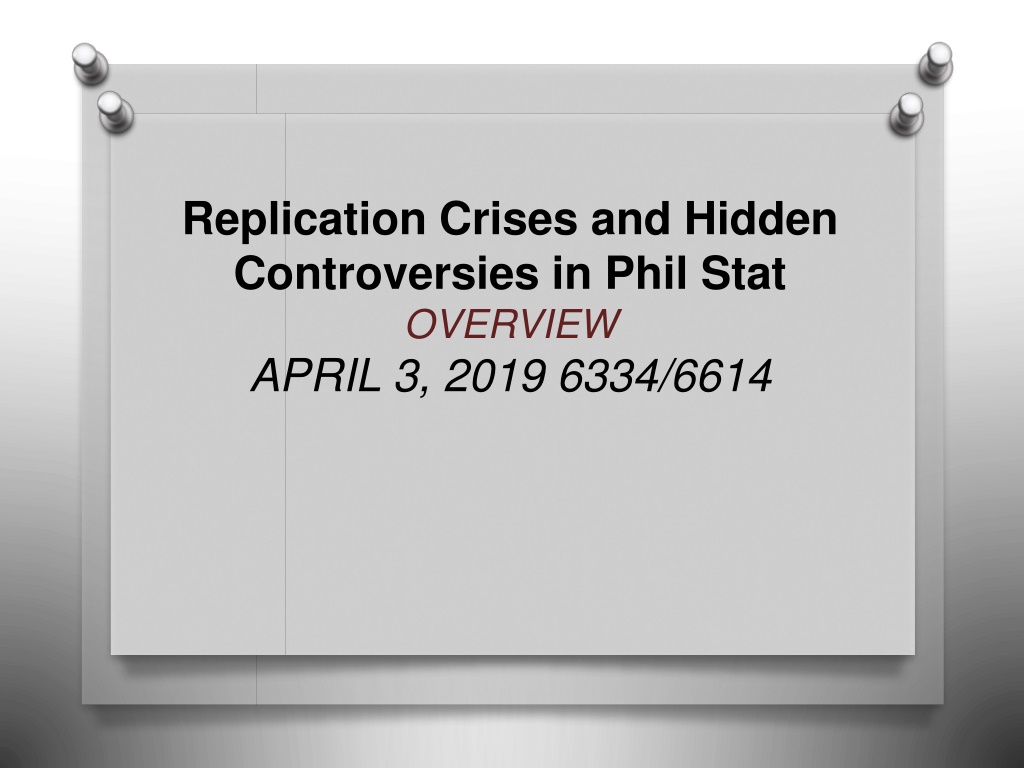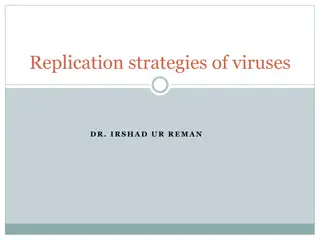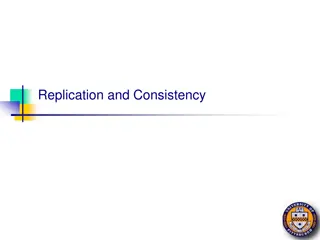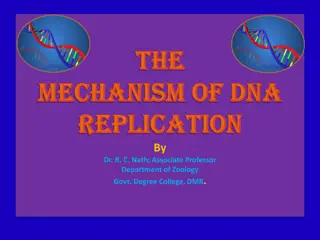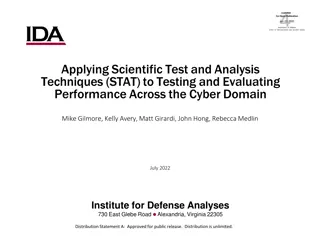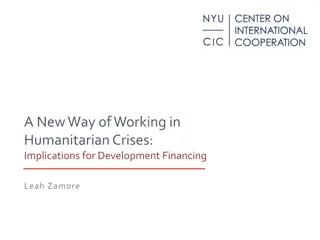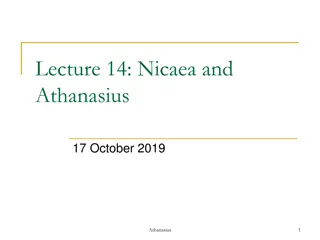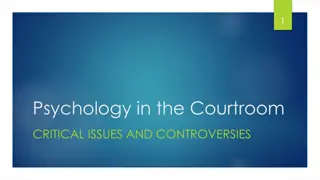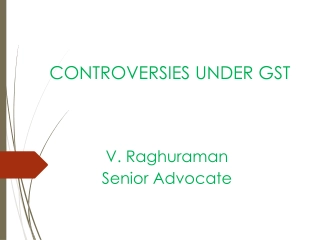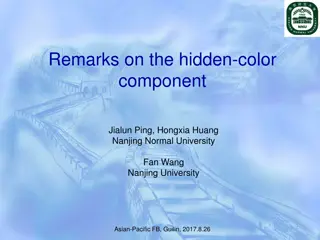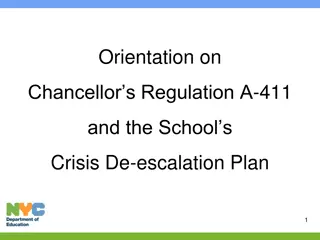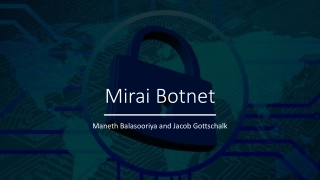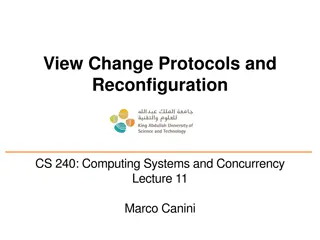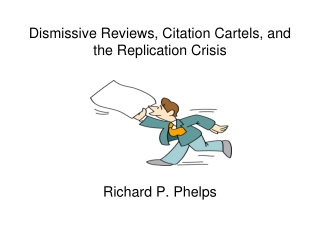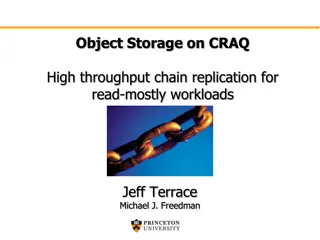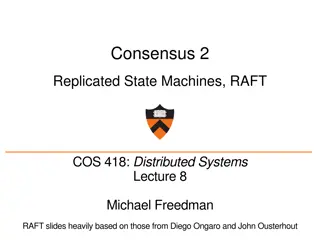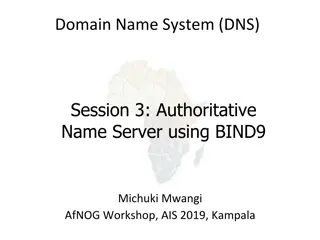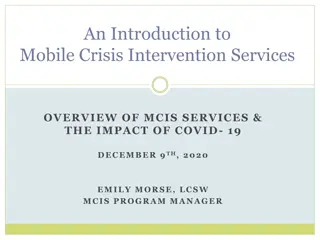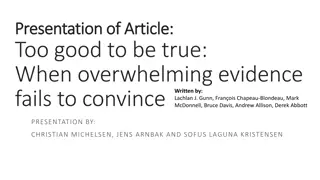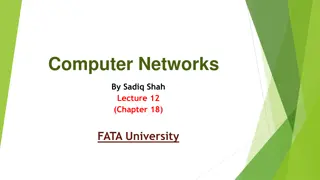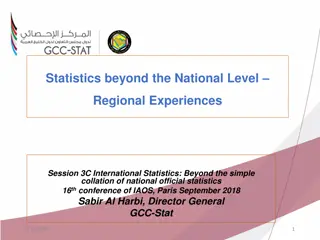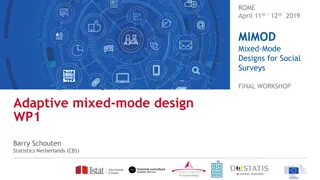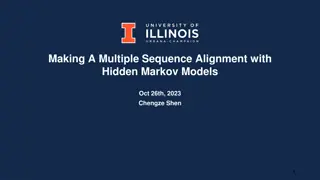Addressing Replication Crises and Hidden Controversies in Phil.Stat
High-profile failures of replication have sparked debates on reforming statistical methods in science. Hidden controversies include Statistics Wars, Replication Paradoxes, and underlying assumptions. Significance tests and p-values play crucial roles, but proper interpretation is essential to avoid errors. Testing reasoning and Neyman-Pearson principles provide insights into making informed decisions based on statistical analyses.
Download Presentation

Please find below an Image/Link to download the presentation.
The content on the website is provided AS IS for your information and personal use only. It may not be sold, licensed, or shared on other websites without obtaining consent from the author. Download presentation by click this link. If you encounter any issues during the download, it is possible that the publisher has removed the file from their server.
E N D
Presentation Transcript
Replication Crises and Hidden Controversies in Phil Stat OVERVIEW APRIL 3, 2019 6334/6614
High-profile failures of replication have brought forth reams of reforms How should the integrity of science be restored? Experts do not agree. We need to pull back the curtain on why. 2
Hidden Controversies 1. The Statistics Wars: Age-old abuses, fallacies of statistics (Bayesian-frequentist, Fisher-N-P debates) simmer below todays debates; reformulations of frequentist methods are ignored 2. Replication Paradoxes: While a major source of handwringing stem from biasing selection effects cherry picking, data dredging, trying and trying again, some reforms and preferred alternatives conflict with the needed error control. 3. Underlying assumptions and their violations A) statistical model assumptions B) links from experiments, measurements & statistical inferences to substantive questions 3
Significance Tests The most used methods are most criticized Statistical significance tests are a small part of a rich set of: techniques for systematically appraising and bounding the probabilities of seriously misleading interpretations of data (Birnbaum 1970, 1033) These I call errorstatisticalmethods (or sampling theory). 4
p-value. to test the conformity of the particular data under analysis with H0in some respect: we find a function T = t(y) of the data, to be called the test statistic, such that the larger the value of T the more inconsistent are the data with H0; The random variable T = t(Y) has a (numerically) known probability distribution when H0is true. the p-value corresponding to any t0bsas p = p(t) = Pr(T t0bs; H0) (Mayo and Cox 2006, 81) 5
Testing Reasoning If even larger differences than t0bsoccur fairly frequently under H0(i.e., P-value is not small), there s scarcely evidence of incompatibility with H0 Small P-value indicates some underlying discrepancy from H0because very probably you would have seen a less impressive difference than t0bswere H0true. This still isn t evidence of a genuine statistical effect H1, let alone a scientific conclusion H* Stat-Sub fallacy H => H* 6
Neyman-Pearson (N-P) tests: A null and alternative hypotheses H0, H1 that are exhaustive H0: 0 vs. H1: > 0 So this fallacy of rejection H1 H*is impossible Rejecting the null only indicates statistical alternatives (how discrepant from null) As opposed to NHST 7
Get beyond N-P/ Fisher incompatibilist caricature Beyond inconsistent hybrid (Gigerenzer 2004, 590): Fisher inferential; N-P long run performance They both use a method s sampling distribution to assess and control error probabilities Results in P-value users robbed of features from N-P tests they need (power) Wrongly supposes N-P testers have fixed error probabilities (no balance), & don t report P-value 8
Replication Paradox (for Significance Test Critics) Critic:It s much too easy to get a small P- value You: Why do they find it so difficult to replicate the small P-values others found? Is it easy or is it hard? 9
Both Fisher and N-P: its easy to lie with statistics by selective reporting Sufficient finagling cherry-picking, P- hacking, significance seeking, multiple testing, look elsewhere may practically guarantee a preferred claim H gets support, even if it s unwarranted by evidence 10
Severity Requirement: Everyone agrees: If the test had little or no capability of finding flaws with H (even if H is incorrect), then agreement between data x0 and H provides poor (or no) evidence for H ( too cheap to be worth having Popper 1983, 30) Such a test fails a minimal requirement for a stringent or severe test My account: severe testing based on error statistics (requires reinterpreting tests) 11
This alters the role of probability: typically just 2 Probabilism. To assign a degree of probability, confirmation, support or belief in a hypothesis, given data x0 (e.g., Bayesian, likelihoodist) with regard for inner coherency Performance. Ensure long-run reliability of methods, coverage probabilities (frequentist, behavioristic Neyman-Pearson) 12
Problems with selective reporting, cherry picking, stopping when the data look good, P-hacking, are not problems about long-runs It s that we cannot say the case at hand has done a good job of avoiding the sources of misinterpreting data Key to revising the role of error probabilities 13
A claim C is not warranted _______ Probabilism: unless C is true or probable (gets a probability boost, is made comparatively firmer) Performance: unless it stems from a method with low long-run error Probativism (severe testing) unless something (a fair amount) has been done to probe ways we can be wrong about C 14
Biasing selection effects: One function of severity is to identify problematic selection effects (not all are) Biasing selection effects: when data or hypotheses are selected or generated (or a test criterion is specified), in such a way that the minimal severity requirement is violated, seriously altered or incapable of being assessed Compare to explaining a known effect (SIST p. 281), as in DNA matching 15
Nominal vs. actual Significance levels SIST p. 275 Suppose that twenty sets of differences have been examined, that one difference seems large enough to test and that this difference turns out to be significant at the 5 percent level. .The actual level of significance is not 5 percent, but 64 percent! (Selvin 1970, 104) From (Morrison & Henkel s Significance Test controversy 1970!) 16
Spurious P-Value You report: Such results would be difficult to achieve under the assumption of H0 When in fact such results are common under the assumption of H0 There are many more ways you can be wrong with hunting (different sample space) (Formally): You say Pr(P-value Pobs; H0) ~ Pobs = small But in fact Pr(P-value Pobs; H0) = high 17
Scapegoating Nowadays, we re likely to see the tests blamed My view: Tests don t kill inferences, people do Even worse are those statistical accounts where the abuse vanishes! 18
Some say taking account of biasing selection effects defies scientific sense SIST P. 269 Two problems that plague frequentist inference: multiple comparisons and multiple looks, or, as they are more commonly called, data dredging and peeking at the data. The frequentist solution to both problems involves adjusting the P-value But adjusting the measure of evidence because of considerations that have nothing to do with the data defies scientific sense (Goodman 1999, 1010) (To his credit, he s open about this; heads the Meta-Research Innovation Center at Stanford) 19
Likelihood Principle (LP) The vanishing act links to a pivotal disagreement in the philosophy of statistics battles In probabilisms, the import of the data is via the ratios of likelihoods of hypotheses Pr(x0;H0)/Pr(x0;H1) The data x0 are fixed, while the hypotheses vary 20
Jimmy Savage on the LP: According to Bayes' theorem, . if y is the datum of some other experiment, and if it happens that P(x| ) and P(y| ) are proportional functions of (that is, constant multiples of each other), then each of the two data x and y have exactly the same thing to say about the values of (Savage 1962, p. 17) 21
All error probabilities violate the LP (even without selection effects): Sampling distributions, significance levels, power, all depend on something more [than the likelihood function] something that is irrelevant in Bayesian inference namely the sample space (Lindley 1971, 436) The LP implies the irrelevance of predesignation, of whether a hypothesis was thought of before hand or was introduced to explain known effects (Rosenkrantz 1977, 122) SIST P. 269 22
Optional Stopping: Error probing capacities are altered not just by cherry picking and data dredging, but also via data dependent stopping rules: Xi ~ N( , 2), 2-sided H0: = 0 vs. H1: 0. Instead of fixing the sample size n in advance, in some tests, n is determined by a stopping rule: 23
Keep sampling until H0 is rejected at 0.05 level i.e., keep sampling until M > 1.96 / n Trying and trying again: Having failed to rack up a 1.96 / n difference after 10 trials, go to 20, 30 and so on until obtaining a 1.96 difference 24
Nominal vs. Actual significance levels again: With n fixed the Type 1 error probability is 0.05 With this stopping rule the actual significance level differs from, and will be greater than 0.05 (proper stopping rule) 25
Probabilist side: Jmmie Savage (1961, 583) declared: optional stopping is no sin so the problem must be with significance levels (because they pick up on it). Performance (and probative testing) side: Peter Armitage: thou shalt be misled if thou dost not know the person tried and tried again. (1962, 72)
Equivalently, you can ensure that 0 is excluded from a confidence interval (or credibility interval) even if true (Berger and Wolpert 1988) Likewise the same p-hacked hypothesis can occur in Bayes factors, credibility intervals, likelihood ratios 27
With One Big Difference: The direct grounds to criticize inferences as flouting error statistical control is lost They condition on the actual data, Error probabilities take into account other outcomes that could have occurred but did not (sampling distribution) 28
What Counts as Cheating? SIST P. 270 [I]f the sampling plan is ignored, the researcher is able to always reject the null hypothesis, even if it is true. This example is sometimes used to argue that any statistical framework should somehow take the sampling plan into account. Some people feel that optional stopping amounts to cheating . This feeling is, however, contradicted by a mathematical analysis. (Eric-Jan Wagenmakers, 2007, 785) But the proof assumes the likelihood principle (LP) by which error probabilities drop out. (Edwards, Lindman, and Savage 1963) 29
Replication researchers (re)discovered that data- dependent hypotheses and stopping are a major source of spurious significance levels. Authors must decide the rule for terminating data collection before data collection begins and report this rule in the articles (Simmons, Nelson, and Simonsohn 2011, 1362). Or report how their stopping plan alters relevant error probabilities. 30
Critic: Its too easy to satisfy standard significance thresholds You: Why do replicationists find it so hard to achieve significance thresholds (with preregistration)? Critic: Obviously the initial studies were guilty of P- hacking, cherry-picking, data-dredging (QRPs) You: So, the replication researchers want methods that pick up on, adjust, and block these biasing selection effects. Critic: Actually reforms recommend methods where the need to alter P-values due to data dredging vanishes 31
Default Bayesian Reforms are touted as free of selection effects Bayes factors can be used in the complete absence of a sampling plan (Bayarri, Benjamin, Berger, Sellke 2016, 100) 33
Recent push to redefine statistical significance is based on the odds ratios/ Bayes Factors (BF) (Benjamin et al 2017) 35
Old & new debates: P-values exaggerate based on Bayes Factors or Likelihood Ratios Testing of a point null hypothesis, a lump of prior probability given to H0 Xi ~ N( , 2), 2-sided H0: = 0 vs. H1: 0. The criticism is the posterior probability on H0can be larger than the P-value. So if you interpret a P-value as a posterior on H0(a fallacy), you d be saying the Pr(H0|x) is low 36
Do P-values Exaggerate Evidence? Don t reject the null until the BF is 20 or 28 Significance testers balk at allowing highly significant results to be interpreted as no evidence against the null or even evidence for it! Bad Type II error Lump of prior on the null conflicts with the idea that all nil nulls are false) P-values can also equal the posterior! (without the spiked prior) even though they measure very different things. 39
When you reject with p = 0.005, you can assign a posterior of .97 to observed sample mean (the max likely value), but there s terrible evidence for this!!! This is like using a confidence level of .5 The severity is .5 To base the argument on lowering P-values on BFs if you don t do inference by means of BFs is not innocuous SIST p. 266 Accepting the LP, Johnson s convinced the problem is merely using p-vaues not low enough 40
BF Advocates Forfeit Their Strongest Criticisms Daryl Bem (2011): subjects did better than chance at predicting the picture to be shown in the future, credit to ESP (SIST P. 283) Admits data dredging Keen to show we should trade significance tests for BFs, critics relinquish their strongest criticism Resort to a default Bayesian prior to make the null hypothesis comparatively more probable than a chosen alternative 41
Bems Response Whenever the null hypothesis is sharply defined but the prior distribution on the alternative hypothesis is diffused over a wide range of values, as it is [here] it boosts the probability that any observed data will be higher under the null hypothesis than under the alternative. This is known as the Lindley-Jeffreys paradox: A frequentist analysis that yields strong evidence in support of the experimental hypothesis can be contradicted by a misguided Bayesian analysis that concludes that the same data are more likely under the null. (Bem et al., 717) 42
Bayes-Fisher Disagreement or Jeffreys-Lindley Paradox With-a lump of prior given to the point null, and the rest appropriately spread over the alternative, an significant result can correspond to Pr(H0 |x) = (1 - )! (e.g., 0.95) spike and smear To a Bayesian this shows P-values exaggerate evidence against 43
Admittedly, significance tests require supplements to avoid overestimating (or underestimating) effect sizes That s what severity does 44
Severity forTest T+: SEV(T+, d(x0), claim C) Normal testing: H0: 0 vs. H1: > 0known ; discrepancy parameter ; 1= 0+ ; d0 = d(x0) (observed value of test statistic) n(M - 0)/ SIR: (Severity Interpretation with low P-values) (a): (high): If there s a very low probability that so large a d0would have resulted, if were no greater than 1, then d0it indicates > 1: SEV( > 1) is high. (b): (low) If there is a fairly high probability that d0 would have been larger than it is, even if = 1, then d0 is not a good indication > 1: SEV( > 1) is low. 45
SIN: (Severity Interpretation for Negative results) (a): (high) If there is a very high probability that d0 would have been larger than it is, were > 1, then 1 passes the test with high severity: SEV( 1) is high. (b): (low) If there is a low probability that d0 would have been larger than it is, even if > 1, then 1 passes with low severity: SEV( 1) is low. 46
Hidden Controversies 1. The Statistics Wars: Age-old abuses, fallacies of statistics (Bayesian-frequentist, Fisher-N-P debates) simmer below todays debates; reformulations of frequentist methods are ignored 2. Replication Paradoxes: While a major source of handwringing stem from biasing selection effects cherry picking, data dredging, trying and trying again, some reforms and preferred alternatives conflict with the needed error control. 3. Underlying assumptions and their violations A) statistical model assumptions B) links from experiments, measurements & statistical inferences to substantive questions 47
Recognize different roles of probability: probabilism, long run performance, probativism (severe testing) Move away from cookbook stat long deplored but don t expect agreement on numbers from evaluations of different things (P-values, posteriors) Recognize criticisms & reforms are often based on rival underlying philosophies of evidence The danger is that some reforms may enable rather than directly reveal illicit inferences due to biasing selection effects Worry more about model assumptions, and whether our experiments are teaching us about the phenomenon of interest 48
